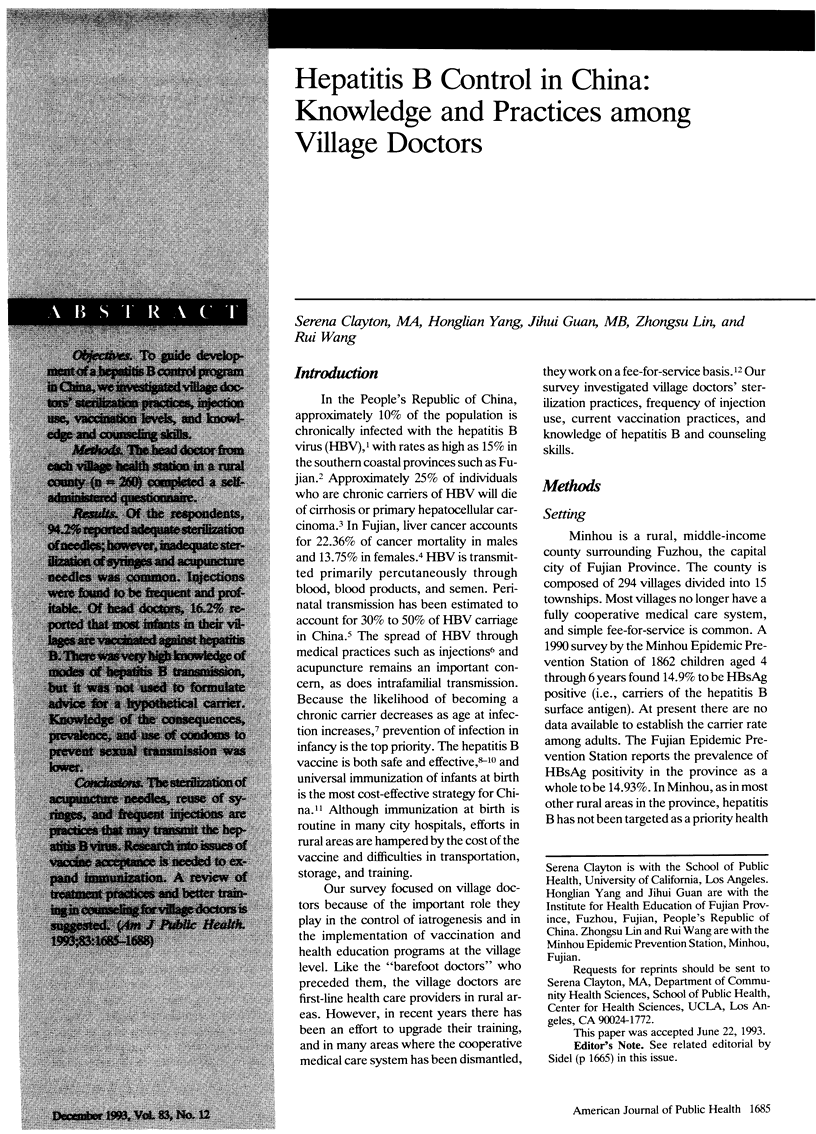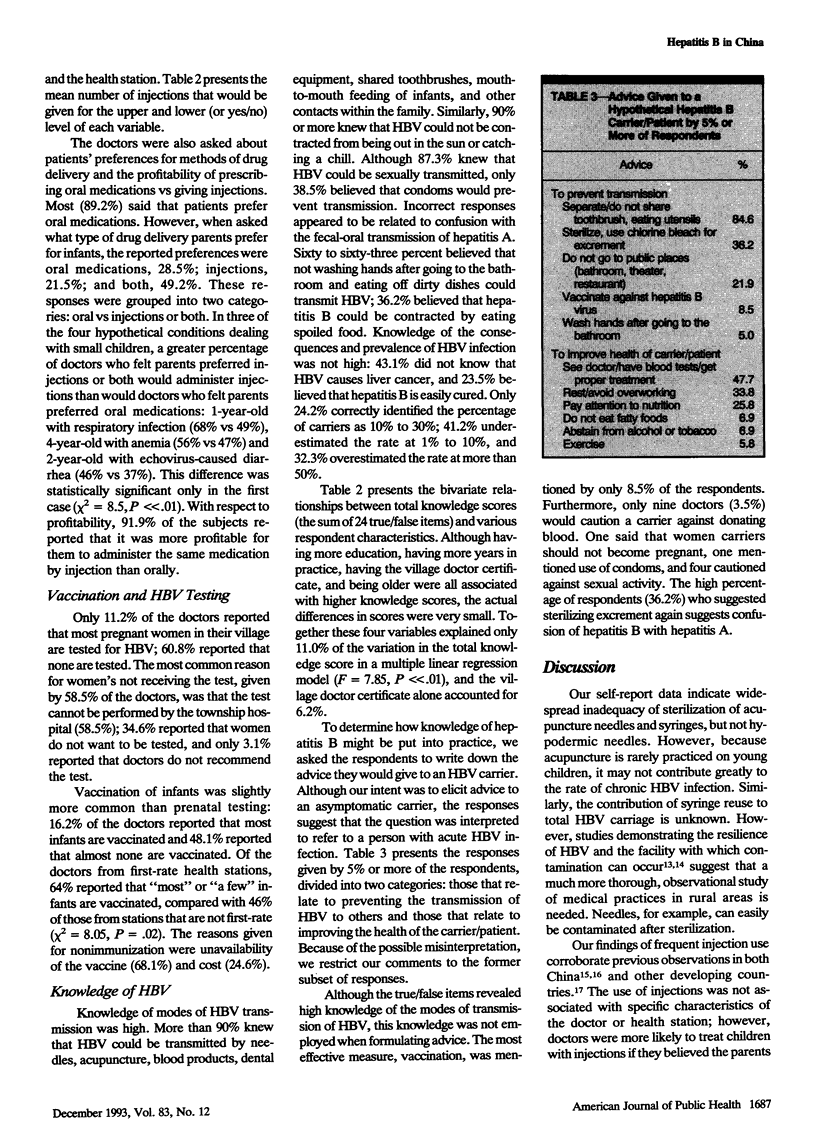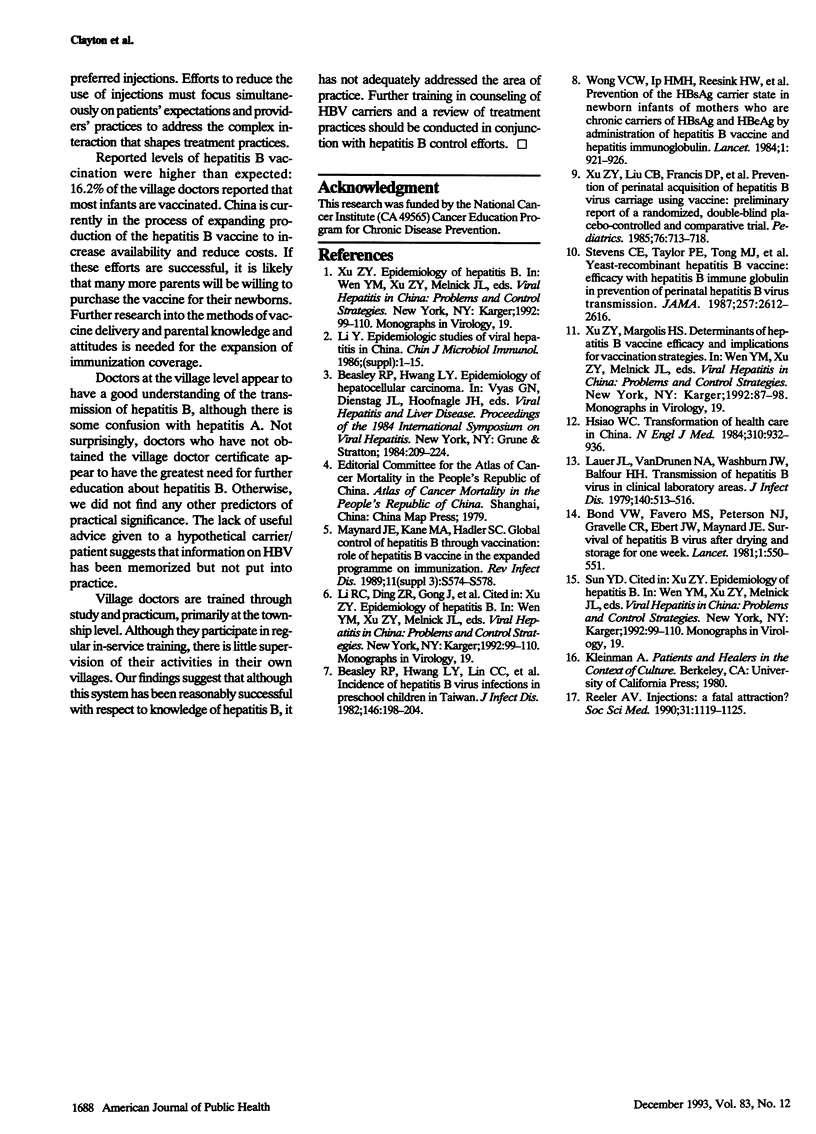Abstract
OBJECTIVES. To guide development of a hepatitis B control program in China, we investigated village doctors' sterilization practices, injection use, vaccination levels, and knowledge and counseling skills. METHODS. The head doctor from each village health station in a rural county (n = 260) completed a self-administered questionnaire. RESULTS. Of the respondents, 94.2% reported adequate sterilization of needles; however, inadequate sterilization of syringes and acupuncture needles was common. Injections were found to be frequent and profitable. Of head doctors, 16.2% reported that most infants in their villages are vaccinated against hepatitis B. There was very high knowledge of modes of hepatitis B transmission, but it was not used to formulate advice for a hypothetical carrier. Knowledge of the consequences, prevalence, and use of condoms to prevent sexual transmission was lower. CONCLUSIONS. The sterilization of acupuncture needles, reuse of syringes, and frequent injections are practices that may transmit the hepatitis B virus. Research into issues of vaccine acceptance is needed to expand immunization. A review of treatment practices and better training in counseling for village doctors is suggested.
Full text
PDF



Selected References
These references are in PubMed. This may not be the complete list of references from this article.
- Beasley R. P., Hwang L. Y., Lin C. C., Leu M. L., Stevens C. E., Szmuness W., Chen K. P. Incidence of hepatitis B virus infections in preschool children in Taiwan. J Infect Dis. 1982 Aug;146(2):198–204. doi: 10.1093/infdis/146.2.198. [DOI] [PubMed] [Google Scholar]
- Bond W. W., Favero M. S., Petersen N. J., Gravelle C. R., Ebert J. W., Maynard J. E. Survival of hepatitis B virus after drying and storage for one week. Lancet. 1981 Mar 7;1(8219):550–551. doi: 10.1016/s0140-6736(81)92877-4. [DOI] [PubMed] [Google Scholar]
- Hsiao W. C. Transformation of health care in China. N Engl J Med. 1984 Apr 5;310(14):932–936. doi: 10.1056/nejm198404053101428. [DOI] [PubMed] [Google Scholar]
- Lauer J. L., VanDrunen N. A., Washburn J. W., Balfour H. H., Jr Transmission of hepatitis B virus in clinical laboratory areas. J Infect Dis. 1979 Oct;140(4):513–516. doi: 10.1093/infdis/140.4.513. [DOI] [PubMed] [Google Scholar]
- Maynard J. E., Kane M. A., Hadler S. C. Global control of hepatitis B through vaccination: role of hepatitis B vaccine in the Expanded Programme on Immunization. Rev Infect Dis. 1989 May-Jun;11 (Suppl 3):S574–S578. doi: 10.1093/clinids/11.supplement_3.s574. [DOI] [PubMed] [Google Scholar]
- Reeler A. V. Injections: a fatal attraction? Soc Sci Med. 1990;31(10):1119–1125. doi: 10.1016/0277-9536(90)90233-i. [DOI] [PubMed] [Google Scholar]
- Stevens C. E., Taylor P. E., Tong M. J., Toy P. T., Vyas G. N., Nair P. V., Weissman J. Y., Krugman S. Yeast-recombinant hepatitis B vaccine. Efficacy with hepatitis B immune globulin in prevention of perinatal hepatitis B virus transmission. JAMA. 1987 May 15;257(19):2612–2616. doi: 10.1001/jama.257.19.2612. [DOI] [PubMed] [Google Scholar]
- Wong V. C., Ip H. M., Reesink H. W., Lelie P. N., Reerink-Brongers E. E., Yeung C. Y., Ma H. K. Prevention of the HBsAg carrier state in newborn infants of mothers who are chronic carriers of HBsAg and HBeAg by administration of hepatitis-B vaccine and hepatitis-B immunoglobulin. Double-blind randomised placebo-controlled study. Lancet. 1984 Apr 28;1(8383):921–926. doi: 10.1016/s0140-6736(84)92388-2. [DOI] [PubMed] [Google Scholar]
- Xu Z. Y., Liu C. B., Francis D. P., Purcell R. H., Gun Z. L., Duan S. C., Chen R. J., Margolis H. S., Huang C. H., Maynard J. E. Prevention of perinatal acquisition of hepatitis B virus carriage using vaccine: preliminary report of a randomized, double-blind placebo-controlled and comparative trial. Pediatrics. 1985 Nov;76(5):713–718. [PubMed] [Google Scholar]


